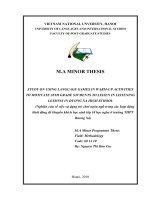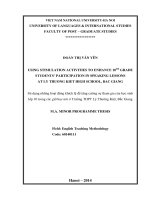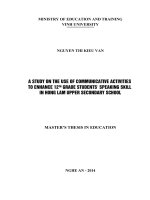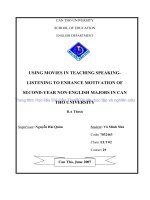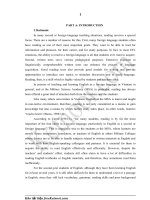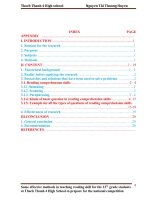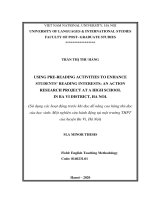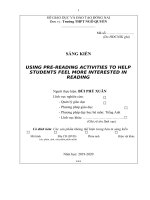USING GAMES IN PRE READING ACTIVITIES TO ENHANCE TENTH GRADE STUDENTS COMPREHENSION
Bạn đang xem bản rút gọn của tài liệu. Xem và tải ngay bản đầy đủ của tài liệu tại đây (3.48 MB, 118 trang )
MINISTRY OF EDUCATION AND TRAINING
VINH UNIVERSITY
ĐÀO KIÊN TRUNG
USING GAMES IN PRE-READING
ACTIVITIES TO ENHANCE TENTH GRADE
STUDENTS' COMPREHENSION
Major: Teaching English to Speakers of Other Languages (TESOL)
Code: 60.14.01.11
MASTER’S THESIS IN EDUCATION
SUPERVISOR:
Ngơ Đình Phương, Assoc. Prof., Ph.D.
Nghệ An, 2017
i
DECLARATION
I hereby declare that this thesis is my own work and effort and that it has
not been submitted anywhere for any award. Where other sources of information
have been used, they have been acknowledged.
ii
ACKNOWLEDGEMENTS
I feel very lucky when I am a student at Vinh University getting
opportunity to do this M.A thesis today. I would like to acknowledge the
supports I received from a number of people in the course of carrying out the
research paper.
First of all, I would like to express my deep gratitude to my lecture Prof.
Dr. Ngo Dinh Phuong. With his patient guidance, useful comments as well as
sincere encouragements, he helped me do my graduation paper easier and more
interesting. Without his help, the thesis would not have been possible.
Secondly, I do wish to take this opportunity to express my sincere thanks
to all Post -Graduate lecturers, who taught and recommended thoughtfully as
well as gave me advice during various stages of learning and writing my master
thesis.
Thirdly, I want to convey my special thanks to the students from class
10.4 in Bac Son secondary school for their help and cooperation during my
research at their class.
In closing, I also thank my family and friends for their enthusiastic
encouragement and support me not only finance but also spirit during the time I
do my thesis.
One more time, thank all these for helping me complete this thesis.
iii
ABSTRACT
This thesis focused on the use of game activities to enhance students’
comprehension in reading lesson at Bac Son Secondary School.
The study was conducted in class 10.4 at Bac Son Secondary School in
the second semester of the school year 2016 – 2017. The study was
implemented on 40 students by using games. The writer used questionnaire,
classroom observations and interviews to get students’ answers.
Through the study, we can see that the students can enhance their
reading comprehension in learning reading. Game activities made students
relax and motivated to read and their comprehension is improved. Based on the
findings, the writer can realize how students felt about activities used in the
class as well as their effectiveness for students. Most of students said that they
thought that games helped student develop their comprehension in reading
lesson.
iv
TABLE OF CONTENTS
DECLARATION................................................................................................i
ACKNOWLEDGEMENTS..............................................................................ii
ABSTRACT.....................................................................................................iii
TABLE OF CONTENTS.................................................................................iv
LIST OF TABLES, CHARTS AND ABBREVIATIONS...............................vii
CHAPTER 1: INTRODUCTION.....................................................................1
1.1. Rationale.....................................................................................................1
1.2. Aims of the study........................................................................................3
1.3. Research Questions....................................................................................4
1.4. Scope of study............................................................................................4
1.5 Methods.......................................................................................................4
1.6. Thesis design..............................................................................................4
CHAPTER 2: LITERATURE REVIEW...........................................................6
2.1. Reading comprehension.............................................................................6
2.1.1. Definition.................................................................................................6
2.1.2. Reading skills..........................................................................................8
2.1.3. Reading comprehension difficulties......................................................10
2.2. Pre-reading stage......................................................................................11
2.2.1. What is Pre-reading?.............................................................................11
2.2.2. Purpose of Pre-reading.........................................................................13
2.2.3. Importance of Pre-reading activities.....................................................16
2.3. A review of the literature of Games.........................................................18
2.3.1. Definition of games...............................................................................18
2.3.2. Games as a teaching method.................................................................20
2.3.3. Roles of games.......................................................................................22
v
2.3.4. How to use games..................................................................................24
2.3.5. Choosing the Game...............................................................................26
2.3.6. Factors affecting the choice of games...................................................26
2.3.7. Adapting the Game................................................................................29
2.3.8. When to Use Language Games.............................................................30
2.3.9. Types of Language Games.....................................................................31
2.3.10. Benefits of games in learning language..............................................32
CHAPTER 3: METHODOLOGY..................................................................36
3.1. Research questions...................................................................................36
3.2. Participants...............................................................................................36
3.3. Materials...................................................................................................37
3.4. Research instruments................................................................................39
3.4.1. Classroom observation..........................................................................39
3.4.2. Questionnaire........................................................................................39
3.4.3. Interview................................................................................................39
3.5. Data collection procedures.......................................................................39
3.5.1. Game activities......................................................................................40
3.5.2. Classroom observations through teaching process...............................40
3.5.3. Post-survey questionnaire for students.................................................40
3.5.4. Post-observation interviews..................................................................41
3.5.5. Technique for analyzing data................................................................41
3.5.6. Summary................................................................................................42
CHAPTER 4: FINDING AND DISCUSSION...............................................43
4.1. Data analysis............................................................................................43
4.1.1. Analyzing result of post-survey questionnaire.......................................43
4.1.2. Analyzing results of classroom observations.........................................47
4.1.3. Results of interviews..............................................................................50
vi
4.2. Discussion................................................................................................57
4.2.1. The use of game technique to stimulate students’ comprehension skill in
reading activities.............................................................................................57
4.2.2. The effectiveness of games used in class...............................................57
4.2.3. The students’ attitude and response on the use of game activities........59
4.3. Suggestions of using language games in pre-reading activities in reading
lessons.............................................................................................................60
4.4. Summary..................................................................................................60
CHAPTER 5: CONCLUSION........................................................................62
5.1. Summary..................................................................................................62
5.2. Implications..............................................................................................63
5.2.1. Implications for the student...................................................................63
5.2.2. Implications for the teacher..................................................................64
5.2.3. Implications for administrator..............................................................65
5.3. Suggestions...............................................................................................66
REFERENCES................................................................................................67
APPENDICES.................................................................................................73
vii
LIST OF TABLES, CHARTS AND ABBREVIATIONS
TABLES
Table 1: Question 1: How do you feel about reading skill?
Table 2: Question 2: How often do you play language games in pre-reading?
Table 3: Question 3: How the game activities help you in reading
comprehension class?
Table 4: Question 4: What benefits you can get from game activities in prereading activities?
Table 5: Question 5: Do the games help you to enhance your comprehension
skill when learning English?
Table 6: Question 6: Do games in pre-reading activities help you comprehend a
text better?
Table 7- Question 7: How the games in pre-reading activities help you in read a
text in reading lesson?
CHARTS
Chart 1- Question 8: Are games in pre-reading activities effective on helping
you to read faster?
Chart 2 – Question 9: Do you think using games or not using games in prereading activities help you read faster?
Chart 3 – Question 10: Do games in pre-reading activities make you read a text
easier?
Chart 4 - Question 11: Do games in pre-reading activities help to solve
difficulties when you comprehend a text?
viii
ABBREVIATIONS
R:
Researcher
Ss:
Students
St:
Student
EFL: English Foreign Language
ESL: English as a Second Language
L2:
Second language
1
CHAPTER 1: INTRODUCTION
1.1. Rationale
Nowadays, English is an important language not only in daily
communication but also in gaining knowledge. Due to the need for exchanges
with countries around the world in all areas of life, English has become one of
the most frequently used language international communication and it is an
indispensable means. In Vietnam, English is becoming more and more important
and is the most commonly used. Previously, language teaching focused on
sentence structure and grammar. Successful or failed English learners depend on
their ability to master grammar and sentence structure rules. At that time,
foreign language teaching was dominated by traditional teaching methods, in
which the teacher dominated all teaching and learning activities in classroom
and teacher is the center of learning.
We live in the twenty-first century, the century of not only modern
civilization but also the century of science technology information. Our country
is in the period of knowledge development based on development of education
and training must be regarded as a top national policy and improve the teaching
and learning quality in order to train human resources for industrialization and
modernization of our country. To survive and develop country, we have to catch
up the developed world requires to grasp the most advanced achievements.
Vietnam aims to get our country becoming a civilized and prosperous country.
Language is the key to conquer human knowledge. However, learning of
English in secondary schools get particular difficulties, specially, students don’t
have interest for this subject. The most important thing that teacher always
towards is bring more enjoyment for student as soon as the beginning of the
lesson.
2
Because of the change of society, teaching methods have also changed to
response the demand for proficient use of English communication skills. This
demand has created high teaching qualities, as well as resources and materials
for learning language process. In addition, the need for appropriate teaching
methods now becomes stronger than ever. As a result, current foreign language
teaching has shifted from teacher to students. Students are the most important
people during learning foreign languages. The learners can learn communication
in real situation, work interpersonal or small-group environments to perform
specific tasks. Learners have opportunities to express their opinions or feelings
and to ask questions if they do not understand the problem.
In fact, in teaching and learning foreign languages, students will learn
more effectively if they learn in a fun, relaxed learning environment and have
more opportunities to communicate in the context of the real world. The use of
language games in foreign language teaching is one of the most effective
methods that can increase students’ learning motivation. At the same time, it
helps and motivates students to maintain their learning and make them interested
in learning. Furthermore, it helps teachers create contexts in which practical
language is useful and understandable to learners. Learners who want to
participate in the game must understand what other people are saying or writing,
and they must speak or write to express their own views or present information
to others. Language games can be used to develop all four skills for students:
Listening, Speaking, Reading and Writing. There are many games that develop
vocabulary, and improve pronunciation. Games are also available to different
students at different levels.
In school, it is a compulsory subject as well as a communicative tool
which help student to get scientific technological knowledge, find in
multiculturalism in the world, and draw closer to international integration.
3
Therefore, learning English is more and more social concern, especially for the
young generation. Because of its special features, English teaching language
method is the most significant problem which is concerned. To have a good
lesson in English and create students’ inspiration give, teachers have to give a
pre reading part attractive for reading lesson. If teacher gives an interesting start,
student can absorb the reading lesson with an interesting atmosphere. As an
English teacher in Bac Son Lower and Upper Secondary School, I understand
difficulties which many students get in learning and using in reading process.
Especially, I concentrate the way that help students to be interested in reading
lesson.
With my experience, using games in teaching and learning is really
effective, especially in pre- reading. Students feel the excitement when they start
a new lesson by games. Moreover, I realize that language games will bring
enjoyment for student and gain lots of improvement as well as change class
atmosphere as reducing stress, boring and making understandable reading
lesson. Therefore, learner can study more effective and deep in the lesson so I
decide to research the importance of pre-reading in reading skill in my thesis
with title: “Using games in pre-reading activities to enhance tenth grade
students’ comprehension”
In this article, I am thinking and giving some language games in English
learning, and the effectiveness can get through research and seeking documents
and some experience of ourselves. I hope that my thesis can be used in teaching
to help student study English better, especially reading skill.
1.2. Aims of the study
The study will emphasize on the main following purposes:
- Investigating the effectiveness of using language games in pre-reading
activities in reading lessons of grade 10 in Bac Son Secondary school.
4
- To identify effects of applying game to develop students’ reading skill
in learning English.
1.3. Research Questions
The study intends to find out the answers to the following questions:
1. How game in pre-reading activities affect students’ comprehension?
2. Do using games help students to read faster?
1.4. Scope of study
The study focuses specifically on using language games in pre-reading
activities to teach reading in Bac Son high school. So the study limits itself to
the teaching and learning reading only, and the subjects of the study are students
from class 10.4 who study Textbook 10 at Bac Son high school.
1.5 Methods
In order to achieve the objectives of the study, the major methods
employed include:
-Survey questionaire with the aims at finding out the effects of games on
students when they are learning reading and their attitude to language game in
pre-reading activities.
-Interview with students who study English to find out their respones
when study reading, and the effectiveness of language games in pre-reading
activities and what their criterials to choose a game are.
-Personal observations
1.6. Thesis design
The thesis consists of the following parts:
Chapter 1: Introduction
Some brief information about the background of the study, the aims, the
scope, research questions as well as method of the study
Chapter 2: Literature review
5
This chapter provides theoretical background relevant to the topic such as
the definition of pre reading and purpose of pre-reading, definition of games,
significance of games in reading comprehension.
Chapter 3: Research methodology
This part presents the study and these include, research questions,
participants, material, procedures and summary.
Chapter 4: Data analysis and discussion
This chapter mentions their analysis and discussion based on data
collected by means of classroom observations, post-survey questionnaires and
interviews.
Chapter 5: Conclusion
Main points and contents of the study are summarized based on the
results of the study. The implication of the study and the recommendation for
further research will be presented.
Appendices consist of the questionnaires for students, interview
questions, observation of Unit 13 and 14.
6
CHAPTER 2: LITERATURE REVIEW
2.1. Reading comprehension
2.1.1. Definition
Reading comprehension is the ability to understand, explain, and answer
questions pertaining to a reading piece. Reading is not a single skill but as a
combination of specific information processing components working together to
derive meaning from print (Frederiksen, 19 82). Reading comprehension is the
process of making meaning from text. The goal, therefore, is to gain an overall
understanding of what is described in the text rather than to obtain meaning
from isolated words or sentences. In understanding read text information
children developmental models, or representations of meaning of the text ideas
during the reading process. There are two classes of mental models: a text-based
model, which is a mental representation of the propositions of the text and a
situation model consisting of what the text is perceived to be about (Kintsch
1998; van Dijk and Kintsch 1983). It includes all of the processes related to
deriving meaning from written language (including books and other forms of
written language) and constructing meaning from written language. “Deriving
meaning” indicates that there is meaning in texts and that meaning needs to be
understood. “Constructing meaning” indicates that often readers go beyond the
meaning explicitly contained in the text and add to that meaning based on their
own experience and their ability to infer additional or deeper meaning. Thus
reading comprehension is much more than the ability to read individual words
and know what those words mean. To comprehend what one reads is to
understand the meaningful message sent by the author.
Reading
comprehension
is
a
very
complex
cognitive
activity.
Comprehenders are not viewed as merely passive recipients of information but
as active constructors of meaning. Skilled comprehenders use a wide repertoire
7
of language skills to gain meaning from text by constructing a text-based model
while at the same time they draw upon and use their own background
knowledge to construct a situation model of the understandings related to the
text passage. To be effective, readers need to be actively engaged in the reading
process by using their metacognitive skills to monitor and regulate their own
meaning making processes.
Comprehension is highly interactive, such that readers use a variety of
skills and processes when encountering text. These processes are complex and
consist of multiple components. A variety of cognitive models have been
developed to lend support to the various skills and processes thought to impact
comprehension (Broek, Young, Tzeng, & Linderholm, 1999; Cromley and
Azevedo, 2007; Graesser, Singer, & Trabasso, 1994; Kintsch & Van Dijk, 1978;
Kintsch & Rawson, 2005).
The importance of reading in learning a foreign language has always been
emphasized and reading has been a rich subject matter for many researchers.
Since the act of reading is not completely understood or easily described
(Aebersold & Field), with the help of new studies and viewpoints, researchers
have tried to develop the definition of reading. Widdowson (1984)states that
reading is a process of getting information by means of print (p. 213). However,
for some researchers, this definition seems too simple since they believe that
reading is a more complicated process. From this perspective, reading has been
described as a cognitive, social and interactive process in which the reader, who
has specific purposes and aims in mind, understands, comprehends and
interprets a written linguistic message given by the writer (Aebersold & Field,
2003; Anderson, 1999; Bernhardt, 1998; Grabe & Stoller, 2002; Grellet, 2006).
The ability to obtain meaningfrom written text through interaction and
involvement with the written language for some purpose is called reading
8
comprehension. Comprehension of a text can be different depending on the
purpose of reading. People generally read for two main reasons, that is, for
pleasure and for information (Grellet, 2006, p. 4). When people read, they read
for a purpose. This purpose determines how people read a text (Aebersold &
Field, 2003). and different kinds of texts require different purposes. Grabe and
Stoller (2002) classify these reading purposes under seven main headings:
reading to search for simple information, reading to skim quickly, reading to
learn from texts, reading to integrate information, reading to write (or search for
information needed for writing), reading to critique texts, and reading for
general comprehension (p. 13).
2.1.2. Reading skills
Reading as a major skill was ignored by pedagogues and researchers for a
long period of time. Most of focus was placed on oral skills (listening and
speaking). For example, the Audio lingual method which was developed in the
United States during world war II when there was a need for people to learn
foreign language rapidly for military purposes emphasized the oral skills,
ignoring reading and considering it a passive skill which was given no emphasis
at all.
In the pre-reading stage, the aim of the teacher is to prepare the students
for the text that they are going to read. It is important for teachers to design and
use activities that can activate the background knowledge of students. These
activities may include brainstorming, semantic mapping, asking questions based
on the title, writing your way into reading (writing about the reader’s own
experiences related to the topic), making predictions based on previewing,
identifying the text structure, skimming for the general idea, writing a summary
of the article based on previewing (Auberbach & Paxton, 1997, p. 259), and
9
vocabulary pre-teaching, which will be discussed in detail later in the literature
review.
Reading skills are a receptive skill in which meaning is extracted from
the discourse (Harmer, 2007). Thus, translating written symbols into
corresponding sounds is not reading; rather, it is decoding (Ur, 2007). Exposure
to easily understood language through reading texts or listening tracks is
considered to be a condition for learning a foreign language. Consequently, the
selection of reading passages in EFL textbooks is mainly directed toward the
choice of what is comprehensible in addition to what is a step further than that
level, as hypothesized by Krashen (Lightbown & Spada, 2006).
The general agreement is that neither too difficult textbooks nor too easy
ones help in second language acquisition. In fact, proficient reading is “an active
process in which learners are capable of comprehending the text, produce
hypotheses about the message of the text and then sample textual cues to
confirm or reject those hypotheses” (Goodman, 1970, as cited in Clarke, 2000,
p. 115).
Ur (2007) added the following characteristics of efficient reading:
The language is comprehensible.
The reading progresses fairly fast.
The reader concentrates on the significant part and skips over
unnecessary details.
The reader thinks ahead, hypothesizes, and predicts what is coming
next.
The reader uses background information in order to understand the text.
The reading is purposeful, and the reader is aware of the purpose of
reading task.
10
Reading activities refer to any activity classroom instructors use to help
the learner bring their background knowledge to connect with the new
information they encounter in the reading in order to get the most understanding
of the message in the reading material.
Reading activities in the present study refer to guessing reading content
from pictures, and pre-reading questioning activities the researcher used to
stimulate the learners’ use of their schema.
Reading comprehension refers to the learners’ level of reading
comprehension ability which was measured by the scores sought from the tests
taken before the implementation of the 2 pre-reading activities.
Satisfaction refers to the learners’ like and dislike towards the use of
games in pre-reading activities (guessing reading content from pictures, and prereading questioning activities) in learning reading comprehension. The learners’
satisfaction level in the present study was measured by the scores obtained from
the questionnaire administered after the experiment.
2.1.3. Reading comprehension difficulties
There may be a multiplicity of factors that contribute to reading
difficulties for many students with special needs and the underlying causes of
their reading problems may be largely unknown (Lewis and Doorlag 1999). It
has been found that the prevalence of children with reading difficulties is often
linked with the economic and social circumstances of the home. For example,
many children identified as having reading difficulties experience significant
language and cultural differences between home and school (Elkins 2002a, b;
McNaughton et al. 2004; Rohl and Rivalland 2002). This finding is supported by
studies conducted in the mid-1970s where variables, such as social class,
educational background of the parents, family income and the number of books
in the home were consistently related to school reading achievement (Romeo
11
2002). The claim is that the respect for education, community standards and the
value placed on education also influenced whether or not students have mastered
basic literacy skills (Samuels 1978).
There are some difficulties that students can get as follow:
Finding enough time and energy
Maintaining concentration
Improving speed
Managing vocabulary
Selecting what to focus on in texts
Understanding new, theoretical or detailed information
Identifying main points and arguments
Evaluating evidence Identifying similarities and differences between
texts
Reading texts that assume background knowledge & experience
Reading different types of text (passage, reports, literature reviews,
letter etc.)
2.2. Pre-reading stage
2.2.1. What is Pre-reading?
Sookchotirat (2005) suggested that pre-reading is the most stage in
reading as it is the basis of all the success in one’s life. Good readers can gain
more knowledge of any kind from reading. Pre-reading makes the reader more
knowledgeable, have wider perspectives and vision. Pre-reading helps the reader
get new ideas leading to cognitive development. When the readers transfer what
they read to apply with their own idea a new perspective or idea is created. The
pre-reading stage is a lesson that occurs before the learners are confronted with a
reading text. Students are prepared mentally before reading the text as “effective
comprehension depends largely on the readers’ “readiness’: entering the page
with an appropriate mental set, orientation” (Manzo et al., 2001).
12
Reading the process of teaching reading, the teacher should have suitable
steps of teaching reading. There should be a pre-reading step to prepare the
reader before they read the whole material. The instructor should provide them
with the pre-reading the learners did not have any background knowledge it
would be the teachers’ responsibility to provide the background knowledge to
the learners in order that they could achieve the most comprehension from the
reading. The teachers should provide the learners with various pre-reading
activities that help them have certain amount of background knowledge about
the reading text because the schema would help the reader get better
comprehension (Graves, Watts and Graves,1994), as shown in the following
studies. Yeeding (2007) investigated the effects of pre-reading activities on
learners’ motivation and reading comprehension ability. Results showed that the
activities subjects were highly motivated, enthusiastic to read. After the
experiment, they scored significantly higher. Pre-reading
activities
are
activities that are used with the students before teaching of the actual
reading
materials.
Pre-reading
activities,
prepare
students
for
better
comprehension by making them familiar with the topic, vocabulary, or
structures that they may come across in the text (Bilokcuoglu, 2011). For
Tudor (1990) pre-reading activities refer to “the range of pedagogical
techniques whereby learners are engaged, prior to their main processing of
a target text, in text-related conceptual activities designed to help them to
process their text in a more meaningful manner" (P. 96).
Haque (2010) sees pre-reading activities as warm-up activities which
prepare students for reading tasks. The activities do not have a set format
and may differ in their length. They may also differ in terms of the
amount of input that is needed for students to complete them. Ausubel
(1963)
views
pre-reading
activities
as
‘advance-organizers’. Advance
13
organizers, provide the necessary information for the learners and activate
their existing knowledge to assist in processing and retaining of the text.
In another experimental study Taglieber, Johnson, & Yarbrough (1988)
provided the experiment subjects with 3 pre-reading activities: guessing reading
content from pictures, learning vocabulary before reading, and pre-reading
question. The control group did not receive any of the 3 pre-reading activities. A
pre-test and post-test were administered to both groups. It was found that the
experimental subject performed better than the control group. In addition, the
reading scores from the reading with guessing reading content from pictures,
and pre-reading questioning were better than the reading with learning
vocabulary before reading.
2.2.2. Purpose of Pre-reading
Several reading researchers like Langer 1984, Adams and Collins 1979,
have highlighted the point that reader's participation of bringing their knowledge
and experience while reading a text is of great importance in reading
comprehension. In order to bring learners knowledge and experience while
reading, pre-reading activities are of great necessity.
Ringler and Weber (1984) cited in Parviz Ajideh (2003:6) call pre-reading
activities as enabling activities because they provide a reader with necessary
background to organize activity and to comprehend the material. According to
the writers these activities can elicit prior knowledge, build background and also
get learners’ attention. As stated by Vacca and Vacca (2002;12) “pre-reading
activities get students ready to read”. Pre-reading activities are any types of
activities that students engage in as preparation for a reading task. At the prereading stage, teachers could prepare the students for the tasks and to familiarize
them with the given topic. The teacher can carry out pre-reading activities that
could assist the students in preparing them to read the texts. As stated by Vacca
14
and Vacca (2002:127) “a key factor related to motivation is activating students’
interest in the text reading”. The pre-reading stage serves as a way to introduce
new vocabulary that is connected to the topic. As pointed out by Nessamalar et
al. (1995:128) pre-reading stage is also used “to introduce language or concepts
which occur in the text but which learners may not know”. Students who are
poor in proficiency would find it difficult to make sense of the text they read.
They cannot make up the words from the text that they are relate the words to
the background knowledge to make meaning. This would prevent the students
from making any use of the background knowledge in interpretation of the text.
Teacher can help their students by carrying out activities that could help build
student background as building and activating prior knowledge for a lesson and
presenting key vocabulary and concepts are also essential to pre-reading
preparation. When students interact with texts, they would relate the information
to their background knowledge and would try to understand what the texts are
about.
There are various pre-reading activities. The type of the activities depends
on the teacher and the type of the text that learners will read. A teacher must
provide pre-reading activities that would match with the text to be
read.
According to Tierney and Cunningham (1984) pre-reading activities acts as a
way to access the reader's former knowledge and "provide a bridge between his
knowledge and the text" (p.610).Tierney and Cunningham break up pre-reading
activities in two parts teacher-centered and student-teacher or peer interaction.
Teacher-centered is one-way question or answer activity. Student-centered
activities are more apt to develop an independent behavior from the beginning.
Pre-reading activities can also be defined as warm-up activities which engage
students in the preparation for a reading task. The activities may differ largely in
their length and the amount of input required to complete it by the student. The
15
activities may even require low-level of student interaction (e.g. showing a
picture to help understanding the context) or involving them to use other skills
as well (e.g. asking students to complete a class survey about a relevant topic).
The choice of the type of pre-reading activities will depend greatly on the kind
of the text to follow and the types of the learners who will be doing the task and
the aim of the pre-reading task. Stoller (1994: 2-7) shows some of the prereading activities along with its definition and benefits.
To stimulate interest in the text.
To help learners bring their prior knowledge to the survey.
To give a reason for reading.
To help learners go on pre-reading passage.
To prepare the reader for the language of the text.
To make them search for specific information.
To help reader to guess the text's ideas.
Direct readers towards the text's key words and ideas.
Pre-reading is the process of skimming a text to locate key ideas before
carefully reading a text (or a chapter of a text) from start to finish. Also
called previewing or surveying. Pre-reading provides an overview that can
increase reading speed and efficiency. Pre-reading typically involves looking at
(and
thinking
about) titles,
chapter introductions, summaries, headings,
subheadings, study questions, and conclusions.
Pre-reading activities help students prepare for the reading activity by
activating the relevant schemata, and motivating them to read. Pre-reading
activities can also help learners anticipate the topic, vocabulary and possibly
important grammar structures in the texts. Here are some activities for you to
think about.
16
According to the National Capital Language Resource Center, pre-reading
is an activity used by teachers to ensure their students are prepared to read a
specific text and understand the reasons they are reading the text. Pre-reading is
an activity used prior to reading a passage or specific text. Pre-reading is
completed within a series of reading activities that also include while-reading
and post-reading activities; the activities involved in pre-reading are completed
for a number of reasons, such as the assessment by a teacher of the linguistic
skills of a student to ensure she is able to read and comprehend the text about to
be read. Pre-reading activities are completed by teachers to ensure each student
understands the reasons for which she is reading a text. A successful series of
pre-reading activities allows a group of students to understand the reasons for
reading a text, such as to build knowledge and to elicit an emotional response to
the text from the student. Pre-reading can also allow a student to make decisions
about whether to read more of the text or find other works by the same author.
2.2.3. Importance of Pre-reading activities
Reading has its own importance to the language learning.
Many
researchers presented that pre-reading activities aids learners comprehending a
text better. The finding theory researcher showed greater importance of
background knowledge for better understanding of the text. There are many
readers who face problems in comprehending a text because of insufficient
background knowledge. Question may arise that "Can we improve students'
reading by activating their background knowledge of the reading topic through
appropriate reading activities?" Many researches possess positive answer to this
question. Carrel and Eisterhold showed the importance as they discuss "the
importance of text previewing activities for ESL readers because of the potential
of cultural specificity of the text content."
For the lower level of English
proficiency learners meaning tend to break at the word level just because they
